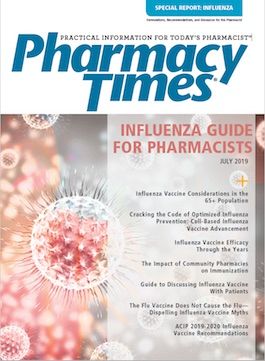Publication
Article
Supplements
Influenza Vaccine Efficacy Through the Years
Author(s):
Influenza vaccine efficacy varies each season based on the circulating flu strains and the patients receiving the vaccination.
Influenza (flu) vaccine efficacy (VE) varies each season based on the circulating flu strains and the patients receiving the vaccination.1 Findings on the effectiveness of the flu vaccine have fluctuated from 2004 through 2018, based on reports from the US Influenza VE Network. The network’s investigators have found that on average, vaccination reduces the incidence of flu-like illness by approximately 40% to 60%.2 The breakdown of the effectiveness of flu vaccines per season from 2004 to 2018 can be seen in the figure.3
Effectiveness of the flu vaccine depends on 2 primary factors2:
- The specific characteristics of the individual being vaccinated (eg, age, health)
- Correspondence between the flu viruses the vaccine is designed to protect against and the flu viruses being disseminated throughout the environment
Although vaccine effectiveness can be difficult to determine based on these factors, the results of recent studies indicate that flu vaccination still aids overall public health.2
The CDC uses a mathematical model to measure the disease burden of flu on affected patients. Analyses of flu illnesses, medical visits, hospitalizations, and deaths are typically used to create season-specific data on burden of disease, vaccine coverage, and VE. During the 2017-2018 flu season, for example, the vaccine was 38% effective.4 That season was severe among all age groups in the United States and led to an estimated 48.8 million cases of flu, 959,000 hospitalizations, and 79,400 deaths.5 Conversely, an estimated 7.1 million illnesses, 109,000 hospitalizations, and 8000 deaths were prevented as a result of flu vaccinations.1,4,5
In the next flu season—from October 1, 2018, to May 4, 2019—the CDC estimated that between 37.4 million and 42.9 million individuals in the United States contracted flu-related illnesses, which led to between 531,000 and 647,000 flu-related hospitalizations and 36,400 to 61,200 flu-related deaths.6 Interim estimates from the US Influenza VE Network for the 2018-2019 flu season indicate that the overall estimated effectiveness of the flu vaccine at preventing flu associated with attended acute respiratory illness was 47%.1
Patients who are at high risk of flu complications, including young children and adults 65 years and older, are at higher risk of hospitalization and morbidity, while most patients with the flu do not require medical attention and will recover within 2 weeks. Indeed, a 2017 study analyzed data from healthy children and those with an underlying high-risk medical illness for the 2010 through 2014 flu seasons, and the results indicated that the flu vaccine decreased the risk of flu-related deaths in 65% of healthy children and in 51% of children with underlying medical conditions. Just 26% of the reported pediatric deaths reported during that time were in patients known to have been vaccinated during the study period.7 Furthermore, patients 65 years and older account for approximately 70% to 90% of flu-related deaths and for 50% to 70% of flu-related hospitalizations, supporting the importance of ensuring that patients in this population are vaccinated each year.8
Flu vaccine effectiveness for the 2018-2019 flu season was estimated to be 61% against all flu types in children aged between 6 months and 17 years, and 24% for all flu types in adult patients 50 years and older.1
It is important to discuss with patients that even when VE is not optimal, benefits of vaccination outweigh the risks associated with the vaccine. Identifying patient misconceptions surrounding vaccines can help pharmacists tailor programs to improve vaccination rates and help meet national health objectives. Pinpointing such barriers can lead to overall growth in vaccination rates and a decrease in vaccine-preventable deaths.9
Rupal Mansukhani, PharmD, is a clinical associate professor at Ernest Mario School of Pharmacy, Rutgers University, New Brunswick, New Jersey.
References
- Doyle JD, Chung JR, Kim SS, et al. Interim estimates of 2018-19 seasonal influenza vaccine effectiveness — United States, February 2019. MMWR Morb Mortal Wkly Rep. 2019;68(6):135-139. doi: 10.15585/mmwr.mm6806a2.
- Vaccine effectiveness: how well do the flu vaccines work? questions and answers. CDC website. cdc.gov/flu/vaccines-work/vaccineeffect.htm. Updated October 12, 2018. Accessed May 28, 2019.
- CDC seasonal flu vaccine effectiveness studies. CDC website. cdc.gov/flu/vaccines-work/effectiveness-studies.htm. Updated May 15, 2019. Accessed May 28, 2019.
- Estimated influenza illnesses, medical visits, hospitalizations, and deaths in the United States — 2017-2018 influenza season. CDC website. cdc.gov/flu/about/burden/2017-2018.htm. Updated December 18, 2018. Accessed May 24, 2019.
- 2017-2018 estimated influenza illnesses, medical visits, and hospitalizations averted by vaccination in the United States. CDC website. cdc.gov/flu/vaccines-work/averted-estimates.htm. Updated February 4, 2019. Accessed May 28, 2019.
- Influenza (flu). CDC website. cdc.gov/flu/. Reviewed June 11, 2019. Accessed June 17, 2019.
- Flannery B, Reynolds SB, Blanton L, et al. Influenza vaccine effectiveness against pediatric deaths: 2010-2014. Pediatrics. 2017;139(5). pii: e20164244. doi: 10.1542/peds.2016-4244.
- People at high risk for flu complications. CDC website. cdc.gov/flu/highrisk/ index.htm. Updated August 27, 2018. Accessed May 23, 2019.
- Bach AT, Goad JA. The role of community pharmacy-based vaccination in the USA: current practice and future directions. Integr Pharm Res Pract. 2015;4:67- 77. doi: 10.2147/IPRP.S63822.







